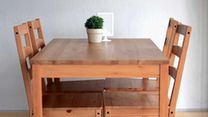
Besides the living room, there’s nowhere you spend more time in your house than in the kitchen because this is where all the cooking takes place. Talking of cooking, there is a variety of cookware to choose from. What separates one type from the other is the material it has been made from. If you are buying cookware for the first time or upgrading, this guide will come in handy.
1. Aluminium cookware
Most Kenyan homes have cookware, (sufurias) made of aluminium. Compared to the other varieties, though not made to please the eye, aluminium cookware is extremely functional, affordable and durable. It’s also indestructible, hence you will likely hand it down to your children and they to their offspring.
Aluminium responds well to a daily scrub from steel wool and a bar soap. This is how they get their shine — a shine that catches so much light, you can see your reflection on it. Since it’s not made with aesthetics in mind, it does not double up as serving ware, even though it is versatile enough to be used as a baking tin in the oven.When buying aluminium cookware, take note of its weight — the heavier and thicker it is, the longer lasting it will be. Weightier cookware also retains its shape over the years. The thinner, lighter ones react to the elements — changes in temperature, especially — and begin to warp after some years of use.
Price tag: Five piece set (no pans), between Sh3,500 and Sh8,000. A single piece, less than Sh1,000.
2. Stainless steel cookware
Stainless steel cookware is the shiny reflective kind. Polished and fancy. It always looks like it has somewhere to go.
Most of this variety comes with handles. Some lids are made of tempered glass, with a small opening to let out the steam when cooking. Stainless steel is not a good conductor of heat like aluminium. That’s why this cookware is made from a heavy base of aluminium or copper, metals that are efficient conductors of heat.
This variety of cookware is pleasant to the eye, and can, therefore, double up as serveware. It, however, cannot go into the oven.
Stainless steel cookware can last a lifetime, it is manufactured from a combination of metals that makes is durable, hardy and easy to care for. So no steel wool to scrub them please, otherwise it will ruin the surface. Warm water, a gentle dish detergent and a sponge will do.
The brands that manufacture original stainless steel cookware are based in France, Germany and Italy.
Price tag: Five piece set, between Sh15,000 and Sh25,000. A single piece, around Sh4,000
3. Non-stick cookware with ceramic coating
Non-stick cookware has a black synthetic chemical coating on the inside and ceramic coating on the outside. Some have, instead, an aluminium or enamel porcelain outer coating painted over. Some are coated with ceramic inside and outside.
They all come with plastic handles and a tempered glass lid. What makes this cookware popular is that you need little to no oil when cooking your food, which makes it a better option for cooking. They are also easy to clean — all you need is warm water, gentle dish detergent and a sponge, steelwool and other harsh scrubbers tend to wear the inner non-stick coating thin.
Non-stick cookware is not oven-safe but it transitions well from the kitchen to the dining table as serveware since it’s attractive.
This variety used to be manufactured in Europe but China has since taken on to manufacturing more pocket-friendly brands.
Couple this with its other advantages and it’s the reason why it’s becoming the go-to cookware in Kenya instead of aluminium.
Price tag: Five-piece set (including a pan), between Sh8,000 and Sh15,000. A single piece, around Sh2,500
4. Cast iron cookware
Cast iron cookware is made from iron and steel. They are popular with skillets, but there are also saucepan sets made from this material. Germany, US and France are synonymous with cast iron cookware.
Most of this type of cookware is matte black, but the saucepans also come in a variety of gorgeous screaming colours such as blood red and lime green. It is naturally heavy cookware.
Cast iron requires specialised care. After use, it’s recommended that you wipe the inside dry with a paper towel. Scrap away any stuck food with a food scraper. Only use dish detergent and water if you absolutely have to. Once rinsed, heat it over a fire for a few minutes to evaporate any moisture left. Never soak it in water overnight because it will rust. It’s also advisable to grease the pan with coconut oil or butter before storing it away for the next use.
There are foods that you should avoid cooking with this type of cook ware, mainly acidic foods such as tomatoes, meats braised in wine and omelettes. This is one of the reasons why this cookware is best reserved for the food experts.
Cast iron cookware is hardy, gorgeous cookware, so it readily doubles up as serve ware. It can also go into the oven safely.
Price tag: Five-piece set (including two skillets), between Sh25,000 and Sh35,000. A single piece, around Sh7,500
5. Sets and dimensions
It is advisable that you save up money and buy matching sets with lids instead of individual pieces with mismatched lids. It makes more functional and economic sense.
Sets usually come with about five to nine pieces of varying dimensions (from 18cm to 26cm/7 inches to 10 inches). Ensure that this set has one shallow and one deep frying pan. Note that you are more likely to get pans from a larger-piece set.



